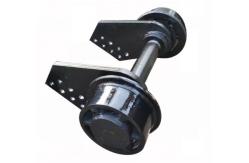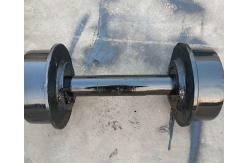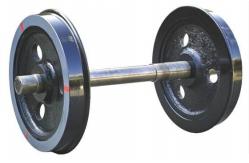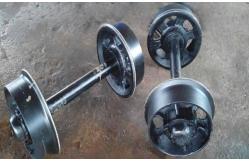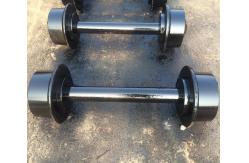Mining Car Use Railway Wheel Set For 762mm Track Gauge ISO Certificate
|
|
Strength of Mining Car Use Railway Wheel Set 762mm Track Gauge Running Gear/ Driver Device for Mining Locomotive Reduce mechanical wear and reduce running resistance
Mining Car Use Railway Wheel Set 762mm Track Gauge Running Gear/ Driver Device for Mining Locomotive The mine wheel pair is a vulnerable component in the coal minetransportation machinery.The basic knowledge quiz of the minecar must be disassembled and repaired after a period of use toimprove its service life.WVith the continuous expansion of the coalmining industry, the traditional manual disassembly can no longermeet the requirements of production. It is imperative to improvethe design of the disassembly machine for the professional knowl edge of the mine car.
The mining wheel has a very good prospect for the future.With thecontinuous development of science and technology, the develop-ment of the dismantling machine of the mine wheel wil be fasterand faster, and it will inevitably develop towards high performance,high precision, high speed, high flexibility and modularization.
The part of the mineral vehicle that is in contact with the rail is composed of two left and rightwheels firmly pressed on the same axle.The role of the wheel pair is to ensure the runningand steering of the rolling stock on the rail, to withstand all static and dynamic loads from therolling stock, to transfer it to the rail, and to transfer the load generated by the uneven line tothe parts of the rolling stock. In addition, the driving and braking of mineral vehicles also workthrough the wheelset.
Mine Mining Push Cart Train Wheel IntroductionMining Car Use Railway Wheel Set 762mm Track Gauge Running Gear/ Driver Device for Mining Locomotive Railway Wheel Set
Mine Mining Push Cart Train Wheel Parameter500mm Gauge Mining Car Wheel Set Wheel Set for The Mining Battery Locomotive, Steel Wheel Set, Mining Battery Locomotive
Wheel set manufacturing:
What is the difference between the detection methods of forgings and castings? The difference is introduced, forgings and castings are quite different, their detection methods are also different, and the requirements are also different. Usually, the quality level of forgings is high, and castings are relatively different from forgings. The requirements will be much lower, so the evaluation criteria for testing are different. The following forging will introduce the difference between forgings and gradual testing methods?
The manufacturing process of castings and forgings is different, resulting in very different internal structures of these two types of workpieces, so the detection methods are also very different. The advantages of forgings are extensible length, retractable cross section; retractable length, extensible cross section; changeable length, changeable cross section. The types of forgings are: free forging/hand forging, hot die forging/precision forging, upset forging, roll forging and die forging. A forging is an object to which a metal is subjected to pressure to shape the desired shape or suitable compressive force through plastic deformation. This force is typically achieved through the use of a hammer or pressure. The casting process builds a refined grain structure and improves the physical properties of the metal. In real-world use of the component, a proper design enables particle flow in the direction of the main pressure. Forgings need to be consistent from piece to piece, without any porosity, excess space, inclusions or other imperfections. This method produces components with a high strength-to-weight ratio.
Castings are metal forming objects obtained by various casting methods, that is, the smelted liquid metal is injected into the pre-prepared casting mold by pouring, injection, suction or other casting methods, and after cooling, after grinding and other subsequent processing methods. , the resulting object of certain shape, size and properties.
Whether it is a casting or a forging, non-destructive testing of the workpiece is necessary to ensure the quality of the product. However, due to the different internal structures of the two types of workpieces, the testing methods and testing precautions are also different. The difference between ultrasonic testing in the casting and forging testing process is explained below.
How to test forgings? Introduction to flaw detection of forgings.
After the forgings are produced and processed, they should be
tested for quality. Only after passing the test can they leave the
factory. Forgings are tested in various ways such as surface
condition testing and mechanical property testing. For important
parts, key parts or large forgings Perform chemical composition
analysis. Therefore, in a sense, the quality inspection of forgings is to check the quality of the forgings on the one hand, and to point out the improvement direction for the forging process on the other hand, so as to ensure that the quality of the forgings meets the requirements of the technical standards for forgings, and meets the design, Processing and use requirements. The inspection of forging quality includes the inspection of appearance quality and internal quality. The appearance quality inspection mainly refers to the inspection of the geometric size, shape, surface condition and other items of the forgings; the internal quality inspection mainly refers to the inspection of the chemical composition, macroscopic structure, microstructure and mechanical properties of the forgings. Specifically, the appearance quality inspection of forgings is to check whether the shape and geometric dimensions of the forgings meet the requirements of the drawings, whether the surface of the forgings is defective, what kind of defects are, and what are their morphological characteristics. The inspection content of the surface condition is generally to check whether the surface of the forging has surface cracks, folds, wrinkles, pressure pits, orange peel, blisters, scars, corrosion pits, bumps, foreign objects, underfill, pits, lack of meat, scratches marks and other defects. The internal quality inspection is to check the internal quality of the forging itself, which is a quality condition that cannot be found by the appearance quality inspection. It includes not only checking the internal defects of the forging, but also checking the mechanical properties of the forging. Chemical composition analysis should also be performed. For internal defects, we will use low magnification inspection, fracture inspection, and high magnification inspection to check whether there are internal cracks, shrinkage holes, porosity, coarse grains, white spots, dendrites, streamlines that do not conform to the shape, and streamlines disorder. , flow through, coarse grain ring, oxide film, delamination, overheating, overburning structure and other defects. For the mechanical properties, it is mainly to check the normal temperature tensile strength, plasticity, toughness, hardness, fatigue strength, high temperature instantaneous rupture strength, high temperature durable strength, durable plasticity and high temperature creep strength. After the forgings are made into parts, their stress, importance, and working conditions are different during use, and the materials and metallurgical processes used are also different. Therefore, different parts are classified into categories according to the above conditions and the requirements of this department. , Different departments and different standards classify forgings differently. But no matter what, the overall quality inspection of forgings is inseparable from two types of inspections, namely the inspection of appearance quality and internal quality, but the types of forgings are different, and the specific inspection items, inspection quantities and inspection requirements are different. . For example, some industrial departments classify structural steel, stainless steel, and heat-resistant steel forgings into Class IV for inspection. How to test forgings? Introduction to forgings flaw detection, the specific inspection items, inspection quantities and inspection requirements of forgings are different. For example, some industrial departments classify structural steel, stainless steel and heat-resistant steel forgings into Class IV for inspection, some departments classify aluminum alloy forgings and die forgings into Class III for inspection according to their usage, and some departments classify aluminum alloy, Copper alloy forgings are classified into Class IV for inspection.
Our Equipments of railway wheel set:
There are strict requirements for the assembly pressure and press-fit process of the axle andthe wheel.The inner distance of the mine wheel must be within 135313 mm. ln order toensure the smooth operation of the mining vehicles, reduce the wheel-rail interaction forceand running resistance, the machining ellipticity and eccentricity of the axle journal and thewheel tread, as well as the journal taper, must not exceed the specified limits.
Services we can provide:
3. Fast , Convinient Services with High quality products but competitive price.
4. Complete quality inspection procedure to every batch of shipment before delivery.
5. After-service can be warranty last to 3 years of any questions from our customers.
Our aim is to serve customers by providing the the most optimized solution according to the needs of production and meet the satisfaction.
Quality control processes for wheel sets:
Forging inspection The existence of forging defects will affect the processing quality or processing quality of the subsequent process, and some will seriously affect the performance and use of the forgings, and even greatly reduce the service life of the finished products and endanger the safety. Therefore, in order to ensure or improve the quality of forgings, in addition to strengthening quality control in the process and taking corresponding measures to eliminate the occurrence of forging defects, necessary quality inspections should also be carried out to prevent subsequent processes (such as heat treatment, surface treatment, cold working) And the forgings with defects that have a bad influence on the performance will flow into the subsequent process. After the quality inspection, remedial measures can also be taken on the forgings according to the nature of the defects and the degree of influence on the use, so that they meet the technical standards or the requirements of use. Therefore, in a sense, the quality inspection of forgings is to check the quality of the forgings on the one hand, and to point out the improvement direction for the forging process on the other hand, so as to ensure that the quality of the forgings meets the requirements of the technical standards for forgings, and meets the design, Processing and use requirements. The inspection of forging quality includes the inspection of appearance quality and internal quality. The appearance quality inspection mainly refers to the inspection of the geometric size, shape, surface condition and other items of the forgings; the internal quality inspection mainly refers to the inspection of the chemical composition, macroscopic structure, microstructure and mechanical properties of the forgings.
What are the factors affecting the heat treatment of forgings? In the production and processing of forgings, in addition to ensuring the required shape and size of the forgings, its internal performance is also crucial. As long as the performance requirements put forward during the use of the workpiece are met, reasonable forging processes and Process parameters can effectively improve the organization and performance of raw materials. The following are the factors that affect the heat treatment of forgings. ① Break the columnar crystals, improve macrosegregation, change the as-cast structure into forged structure, and weld the internal voids under suitable temperature and stress conditions to improve the density of the material; ② The ingot is forged to form a fibrous structure, and further through rolling, extrusion and die forging, the forgings can obtain a reasonable distribution of fiber directions; ③ Control the size and uniformity of grains; ④ Improve the distribution of the second phase (such as alloy carbides in ledeburite); ⑤ Make the organization get deformation strengthening or deformation-phase transformation strengthening, etc. Due to the improvement of the above structure, the plasticity, impact toughness, fatigue strength and lasting properties of the forgings are also improved, and then the required hardness, strength and plasticity of the parts can be obtained through the final heat treatment of the parts. performance.
Specifically, the appearance quality inspection of forgings is to check whether the shape and geometric dimensions of the forgings meet the requirements of the drawings, whether the surface of the forgings is defective, what kind of defects are, and what are their morphological characteristics. The inspection content of the surface condition is generally to check whether the surface of the forging has surface cracks, folds, wrinkles, pressure pits, orange peel, blisters, scars, corrosion pits, bumps, foreign objects, underfill, pits, lack of meat, scratches marks and other defects. The internal quality inspection is to check the internal quality of the forging itself, which is a quality condition that cannot be found by the appearance quality inspection. It includes not only checking the internal defects of the forging, but also checking the mechanical properties of the forging. Chemical composition analysis should also be performed. For internal defects, we will use low magnification inspection, fracture inspection, and high magnification inspection to check whether there are internal cracks, shrinkage holes, porosity, coarse grains, white spots, dendrites, streamlines that do not conform to the shape, and streamlines disorder. , flow through, coarse grain ring, oxide film, delamination, overheating, overburning structure and other defects. For the mechanical properties, it is mainly to check the normal temperature tensile strength, plasticity, toughness, hardness, fatigue strength, high temperature instantaneous rupture strength, high temperature durable strength, durable plasticity and high temperature creep strength. After the forgings are made into parts, their stress, importance, and working conditions are different during use, and the materials and metallurgical processes used are also different. Therefore, different parts are classified into categories according to the above conditions and the requirements of this department. , Different departments and different standards classify forgings differently. But no matter what, the overall quality inspection of forgings is inseparable from two types of inspections, namely the inspection of appearance quality and internal quality, but the types of forgings are different, and the specific inspection items, inspection quantities and inspection requirements are different. . For example, some industrial departments classify structural steel, stainless steel and heat-resistant steel forgings into Class IV for inspection, some departments classify aluminum alloy forgings and die forgings into Class III for inspection according to their usage, and some departments classify aluminum alloy, Copper alloy forgings are classified into Class IV for inspection.
Railway parts products we can provide:
|
||||||||||||||||||||||||
| Product Tags: 762mm Railway Wheel Set Mining Car Railway Wheel Set | ||||||||||||||||||||||||
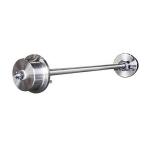
|
300mm Size Forged Steel Railroad Wheels And Axles |
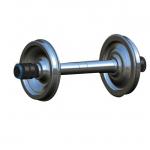
|
ISO9001 2008 Train Car Wheels ODM OEM For Electric Locomotive Rollings |
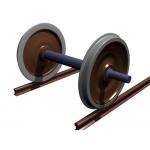
|
Industrial Railway Wheel Set , Kingrail Railroad Wheels For Trucks 650mm Gauge ODM |
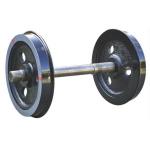
|
Casting Rail Wheel Set , Steel Train Wheels 350mm For Locomotive Wagon |
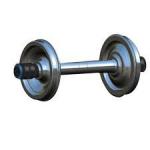
|
600mm Gauge Railway Wheel Set Heavy Duty 42CrMo Steel Flanged Material |
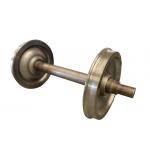
|
OEM Railroad Train Wheels , 450mm Forged Steel Wheel ISO9001 2008 |

